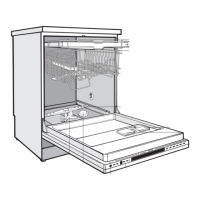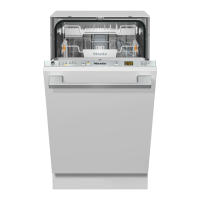Do you have a question about the Miele G 2872 SCVi and is the answer not in the manual?
Visual identification of major dishwasher components and their labels.
Explanation of control panel buttons, indicators, and how information is shown on the display.
Information about connecting the dishwasher to the Miele@home network and its capabilities.
Precautions to prevent harm to children using or near the dishwasher.
Electrical safety requirements and installation precautions for the appliance.
Proper installation methods and safe operating practices for the dishwasher.
Instructions for safely and environmentally disposing of the old dishwasher.
Guidance on recycling and disposing of dishwasher packaging responsibly.
Recommendations for efficient water and electricity usage during dishwashing cycles.
Procedures for opening and closing the dishwasher door correctly.
Setting the appliance language and configuring the clock display.
Setting the current time on the dishwasher display.
Essential items and setting water hardness for initial use.
Step-by-step guide to filling the salt reservoir correctly.
How to respond to 'Insufficient salt' and 'Rinse aid low' warnings.
Understanding the purpose of rinse aid and how to add it.
Key principles for loading crockery for optimal cleaning and item placement.
List of items that should not be washed in the dishwasher due to material or finish.
Arranging items in the upper basket, including spiked inserts and cup racks.
How to adjust the upper basket height for different plate sizes and tall items.
Instructions for loading the lower basket and using vario inserts for various items.
Using the bottle holder and narrow vario insert for specific items.
Methods for loading cutlery trays and baskets for effective cleaning.
Information on different detergents and how to add them to the dispenser.
Step-by-step instructions for adding detergent to the dispenser compartment.
Steps to power on the dishwasher and choose a wash cycle.
How to select additional functions like Turbo or Pre-wash for programmes.
Procedures for starting a cycle and understanding time display.
Actions at the end of a cycle, including unloading, powering down, and pausing.
Steps to modify or cancel and restart a wash programme.
How to set a delayed start time for wash programmes.
Maintenance of the dishwasher door, seals, and indicator light panel.
How to clean the exterior control surfaces safely and effectively.
Checking and cleaning the wash cabinet filters for optimal performance.
Steps to remove and clean the spray arms to ensure proper water distribution.
Troubleshooting common technical faults like non-starting or stopping.
Diagnosing and fixing problems related to water intake or drainage.
Solutions for common issues like dark displays or buzzer alerts.
Identifying and resolving unusual noises and unsatisfactory cleaning outcomes.
Diagnosing and fixing issues causing unclean dishes or smearing.
Troubleshooting problems with dishes not drying or showing white residue.
Solutions for glassware with tinges, dullness, or discolouration.
Procedure for cleaning the filter in the water inlet hose.
Steps to clean the drain pump and non-return valve for proper drainage.
Guide to selecting programmes based on crockery type and food soil.
Overview of wash programmes and required detergent in compartments.
Details on programme stages, temperatures, and drying phases.
Data on energy, water usage, and cycle times for each programme.
Explanations for specific programmes like Hygiene, Pasta, and Plastics.
Information on how to get assistance for appliance faults and repairs.
Details on how appliance software can be updated by a technician.
How to obtain data for comparison testing and noise level measurements.
List of optional accessories to improve dishwasher functionality and user experience.
Guidelines and safety precautions for connecting the appliance to the UK mains supply.
Explanation of the Miele waterproof system for preventing water damage.
Instructions for connecting the dishwasher to the water supply, including pressure requirements.
Proper methods for connecting the drain hose and venting the system.
Key technical details including height, width, depth, voltage, and capacity.
How to enter and move through the dishwasher's settings menu.
Customizing the display language and time format.
Setting the appliance for different types of detergents (powder, tabs).
Adjusting drying behaviour and setting water hardness for optimal performance.
Adjusting rinse aid dosage and setting filter check reminders.
Optimizing the Sensor wash programme for stubborn soiling.
Rearranging favourite programmes in the main menu for quicker access.
Setting additional functions to be automatically selected for programmes.
Selecting temperature display between Celsius (°C) and Fahrenheit (°F).
Adjusting buzzer volume and understanding fault alert tones.
Customizing button press tones and screen brightness levels.
Saving and recalling the last used programme automatically.
Managing demonstration modes and restoring default settings.
Visual identification of major dishwasher components and their labels.
Explanation of control panel buttons, indicators, and how information is shown on the display.
Information about connecting the dishwasher to the Miele@home network and its capabilities.
Precautions to prevent harm to children using or near the dishwasher.
Electrical safety requirements and installation precautions for the appliance.
Proper installation methods and safe operating practices for the dishwasher.
Instructions for safely and environmentally disposing of the old dishwasher.
Guidance on recycling and disposing of dishwasher packaging responsibly.
Recommendations for efficient water and electricity usage during dishwashing cycles.
Procedures for opening and closing the dishwasher door correctly.
Setting the appliance language and configuring the clock display.
Setting the current time on the dishwasher display.
Essential items and setting water hardness for initial use.
Step-by-step guide to filling the salt reservoir correctly.
How to respond to 'Insufficient salt' and 'Rinse aid low' warnings.
Understanding the purpose of rinse aid and how to add it.
Key principles for loading crockery for optimal cleaning and item placement.
List of items that should not be washed in the dishwasher due to material or finish.
Arranging items in the upper basket, including spiked inserts and cup racks.
How to adjust the upper basket height for different plate sizes and tall items.
Instructions for loading the lower basket and using vario inserts for various items.
Using the bottle holder and narrow vario insert for specific items.
Methods for loading cutlery trays and baskets for effective cleaning.
Information on different detergents and how to add them to the dispenser.
Step-by-step instructions for adding detergent to the dispenser compartment.
Steps to power on the dishwasher and choose a wash cycle.
How to select additional functions like Turbo or Pre-wash for programmes.
Procedures for starting a cycle and understanding time display.
Actions at the end of a cycle, including unloading, powering down, and pausing.
Steps to modify or cancel and restart a wash programme.
How to set a delayed start time for wash programmes.
Maintenance of the dishwasher door, seals, and indicator light panel.
How to clean the exterior control surfaces safely and effectively.
Checking and cleaning the wash cabinet filters for optimal performance.
Steps to remove and clean the spray arms to ensure proper water distribution.
Troubleshooting common technical faults like non-starting or stopping.
Diagnosing and fixing problems related to water intake or drainage.
Solutions for common issues like dark displays or buzzer alerts.
Identifying and resolving unusual noises and unsatisfactory cleaning outcomes.
Diagnosing and fixing issues causing unclean dishes or smearing.
Troubleshooting problems with dishes not drying or showing white residue.
Solutions for glassware with tinges, dullness, or discolouration.
Procedure for cleaning the filter in the water inlet hose.
Steps to clean the drain pump and non-return valve for proper drainage.
Guide to selecting programmes based on crockery type and food soil.
Overview of wash programmes and required detergent in compartments.
Details on programme stages, temperatures, and drying phases.
Data on energy, water usage, and cycle times for each programme.
Explanations for specific programmes like Hygiene, Pasta, and Plastics.
Information on how to get assistance for appliance faults and repairs.
Details on how appliance software can be updated by a technician.
How to obtain data for comparison testing and noise level measurements.
List of optional accessories to improve dishwasher functionality and user experience.
Guidelines and safety precautions for connecting the appliance to the UK mains supply.
Explanation of the Miele waterproof system for preventing water damage.
Instructions for connecting the dishwasher to the water supply, including pressure requirements.
Proper methods for connecting the drain hose and venting the system.
Key technical details including height, width, depth, voltage, and capacity.
How to enter and move through the dishwasher's settings menu.
Customizing the display language and time format.
Setting the appliance for different types of detergents (powder, tabs).
Adjusting drying behaviour and setting water hardness for optimal performance.
Adjusting rinse aid dosage and setting filter check reminders.
Optimizing the Sensor wash programme for stubborn soiling.
Rearranging favourite programmes in the main menu for quicker access.
Setting additional functions to be automatically selected for programmes.
Selecting temperature display between Celsius (°C) and Fahrenheit (°F).
Adjusting buzzer volume and understanding fault alert tones.
Customizing button press tones and screen brightness levels.
Saving and recalling the last used programme automatically.
Managing demonstration modes and restoring default settings.
| Door color | Not applicable |
|---|---|
| Cord length | 1.7 m |
| Control type | Buttons |
| Built-in display | Yes |
| Appliance placement | Fully built-in |
| Control panel color | Stainless steel |
| Noise level | 41 dB |
| Delay start (max) | 24 h |
| Dishwashing programs | Eco, Quick |
| Number of place settings | 14 place settings |
| Number of washing programs | 6 |
| Current | 10 A |
| Connected load | 2200 W |
| AC input voltage | 230 V |
| AC input frequency | 50 Hz |
| Water consumption per cycle | 10 L |
| Energy consumption per cycle | 1.08 kWh |
| Depth | 570 mm |
|---|---|
| Width | 598 mm |
| Height | 845 mm |
| Weight | 61000 g |
| Installation compartment width | 600 mm |
| Installation compartment height (max) | 910 mm |











